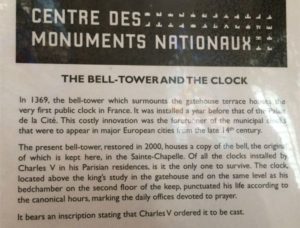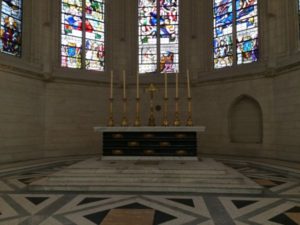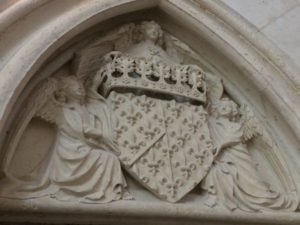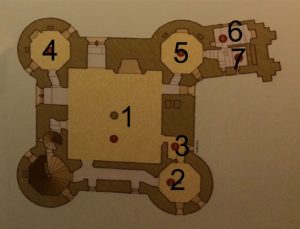| We set off after breakfast, having worked out which of the many colourful metro lines would take us to our destination. It was drizzly and cool but we barely noticed. Arriving at Vincennes, we followed our trusty Google Maps and behold, were led straight to the chateau. Outside was a magnificent statue of Saint Louis. All written information provided on site at Vincennes. |
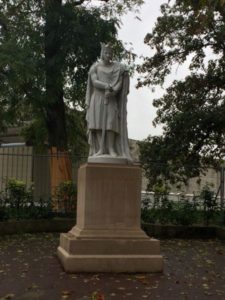 |
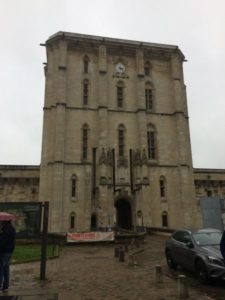 |
 |
The Chapel - Sainte Chappelle de Vincennes
| King Charles V was very fond of his castle at Vincennes and sought to extend the political and religious influence it exerted. That is why he founded the Sainte Chapelle in 1379, placing it under the patronage of the Trinity and the Virgin Mary. Works were directed by the architect Raymond Du Temple and started in 1390. The major construction works on the choir, two oratories, sacristy and treasure house were in all likelihood completed in 1396. But because of the military and financial difficulties facing the kingdom and the madness of Charles VI, the works were interrupted at the beginning of the 15th century. |
 |
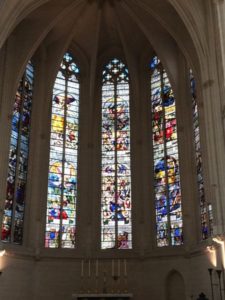 |
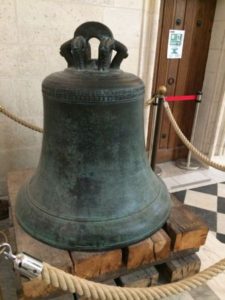 |
|
|
|
|
The Donjon - built by Charles V
 |
 |
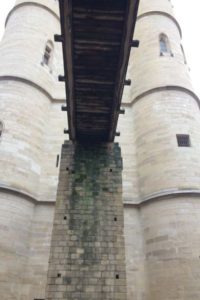 |
| The above images show the only entrance to the donjon and then the First floor - Grand Hall; Second floor - Apartments of Charles V; Top floor - Servants and military. Once through the gate, as seen in the third image, you still had to cross the bridge. View in picture is from ground floor looking up to the bridge that takes you to the grand hall. |
View of Donjon and ground floor once inside.
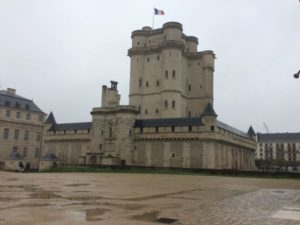 |
 |
 |
Formal Study
| Once inside the donjon, one has to climb a large staircase and at the first floor level is the formal study of Charles V. He spent two or three months a year at Vincennes, and while he was here governed his kingdom from this small room. From here he undertook the reconquest of his lands, the restorations of royal power and the recovery of France. The adjoining rooms were occupied by his staff whose job it was to draft documents. From the window, he could clearly see the entrance to his domain, always mindful of the surprise attack on his home in Paris. At Vincennes, he would make sure this would never happen again. To gain entrance to his home proper, one had to pass the study to cross the bridge. |
 |
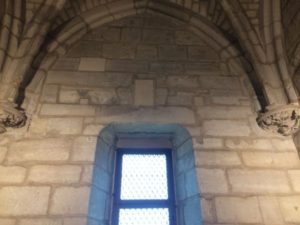 |
 |
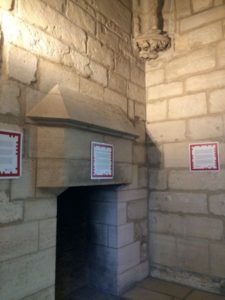 |
| The first image (above) is looking out from the study, over the keep. Image two is the one window in Charles formal study from where he could watch the comings and goings of the traffic. The third images shows what the study would have looked like in 1369. |
The Great Hall
 |
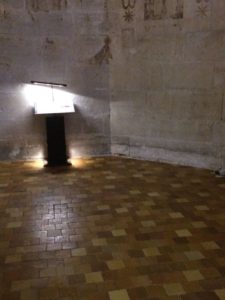 |
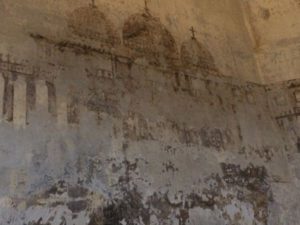 |
 |
| The third image (above) shows the beautiful religious scenes painted onto the walls, and the last image, the arched ceilings that would have been brightly painted in blue, red, green and yellow. |
The Second Floor - 1) the King's apartments
| The second floor is occupied by the King's apartments. The central room was the king's bedchamber (1) the corner towers housed the royal chapel (2) linked to an oratory (3) the wardrobe (4) and the treasury (5). Further on are the study (6) and the latrines (7). These rooms were almost all fully wood-panelled and heated by canopied fireplaces. The bedchamber was luxurious and comfortable with large windows, decorative carving, painted wood panelling and ancillary rooms. In 1461, Florrentine ambassadors discovered and marvelled at the sophistication of its decor. Here Charles V stored the most precious manuscripts from his library and his finest pieces of gold and silver ware. A coffer, standing in the window recess to the left of the fireplace, held religious manuscripts, including two psalters that had belonged to Saint Louis.
The upper floors accommodated the chamberlains, the king's inner circle and servants as well as domestic and military stores such as the supplies for the machines of war lined up on the terrace. |
2) The chapel and 3) the oratory
 |
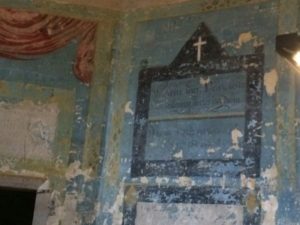 |
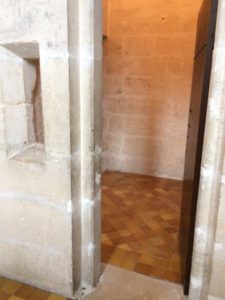 |
| When the gatehouse clock bell chimed the canonical hours, the chaplain came here to celebrate the religious offices watched by the king from the adjoining oratory. It is noted the chapel had no fireplace and it is evident from the rebates of the stone window jambs, that there had been stained glass windows. Several times a day Charles V would shut himself away in the oratory to follow the religious services celebrated in the chapel. |
4) The garde-robe
| This room was used as the king's wardrobe; the king's linen was kept here in coffers. Under the vaulting and at the top of the walls, well-preserved elements of the original wood panelling can still be seen. The sculptures come from the outside walls of the keep. They are brackets at the base of the moulded window frames, now replaced by copies. They depict prophets bearing a message, fantastical figures and angels with musical instruments singing in the praise of God and expressing the joy of those who will be permitted into Paradise. Here there is one angel playing an organ and the other playing a hurdy gurdy. |
 |
 |
5) The Treasury
| The Treasury leads to the rooms strictly reserved for Charles V. In his absence the door was locked, sealed with wax and the king kept the only key. From 1367, the room was used to store the kingdom's gold, together with the king's collection of manuscripts and objects d'art. Charles V wished to have a large amount of money constantly available at his main residences and he made Vincennes the place where the kingdom's treasure was kept. The coffers could contain up to 20% of the annual budget for royal expenses. |
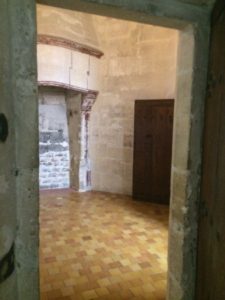 |
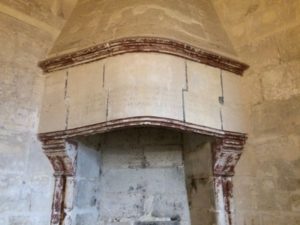 |
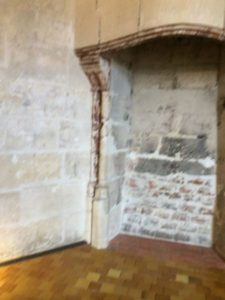 |
6) Private Study
| This room satisfied Charles V's desire to have a comfortable place to read, work and keep his documents and valuables. This small, easily heated room is well-lit by a large window through which he could look out over Paris. It was entirely wood-panelled, furnished with shelves of valuable books, objects, reliquaries, and jewels. In the left niche stood a coffer in which the family documents were kept. The king worked at the centre of a decorative carving, a sign of his piety: the four evangelists are portrayed on the consoles and the Holy Trinity on the keystone. |
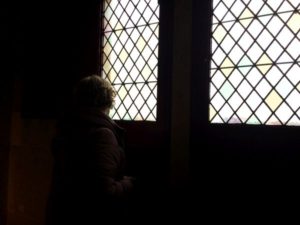 |
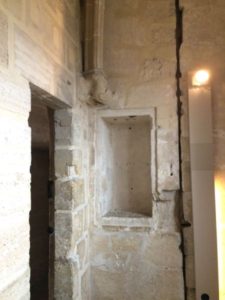 |
 |
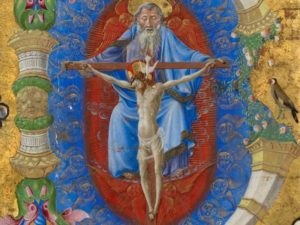 |
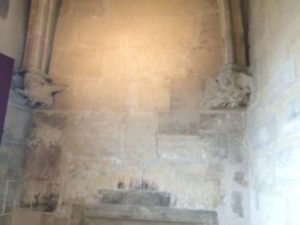 |
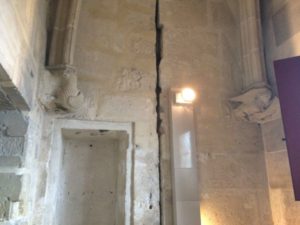 |
 |
 |
| The first four images (above) are Cathy A looking out the window across to Paris just as Charles V would have done, the niche where the family documents were kept, the Holy Trinity on the ceiling in the centre of the room and the sort of colouring it would have had.
The following fours images in the second row are the The four Evangelists, Matthew, Mark, Luke and John, then John the Eagle and Luke the Ox and finally, Mark the Lion and Matthew the Man. |
7) The Latrines
| This was an innovative, hygienic and convenient feature in Charles V's time. In particular the walls were entirely wood-panelled and a wooden partition provided privacy. Note the short height of the doorway! |
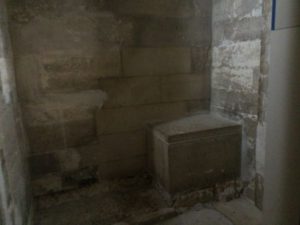 |
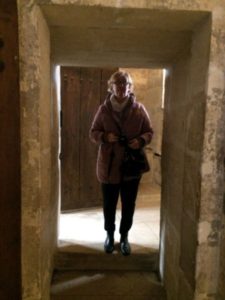 |
The Walkway
| Running from the King's official study at the top of the main staircase (before the bridge) there is a long corridor or walkway which turns three times as it runs around the exterior of the donjon. From here the soldiers keep constant guard, the openings in the floor every few paces possibly old 'murder holes' through which hot tar could be poured. |
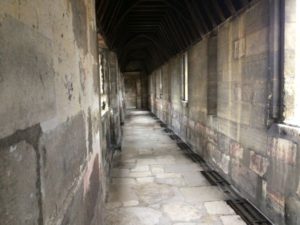 |
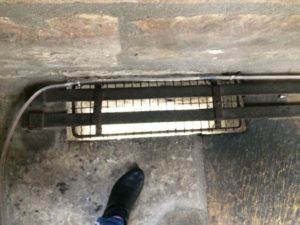 |
 |
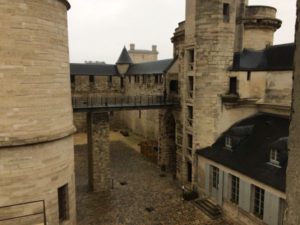 |
The Courtyard
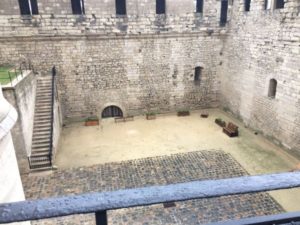 |
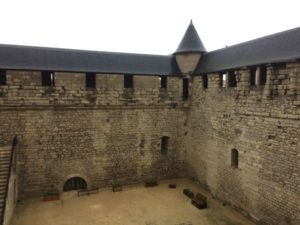 |
 |
 |
Vincennes Keep as a prison
| From the Middle Ages the kings of France had, because of their roles as senior dispenser of justice, a place in each of their residences to incarcerate prisoners. In the late 15thC Louis XI adapted the keep to hold some of his prisoners there, often great men who had fallen into disgrace. From the 16th C the keep officially became a prison, though some residents were allowed their staff and personal affects. From the 17thC prisoners were sent there to be kept in solitary confinement, like Fouquet 1615 -1680, Superintendent of Finances, imprisoned in 1615 on the orders of Louix XIV. Some were victims of royal lettre de cachet that is, imprisoned without a trial. Others were imprisoned for writings that seemed subversive like Diderot and later, the Marquis de Sade. |
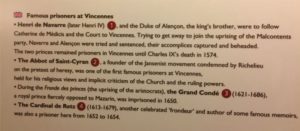 |
 |
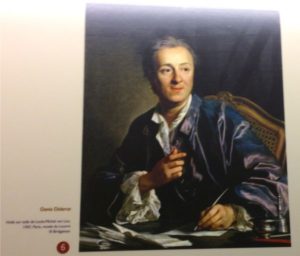 |
The Marquis de Sade's cell
| Writer, hedonist philosopher, atheist, scandalous and provocative, Donatien Alphonse Francois de Sade (1740 - 1814) was notorious for pornographic passages in his works supported by philosophical justifications together with his libertine lifestyle. He was imprisoned in Vincennes on two occasions. The first time for fifteen days for outrageous behaviour in a brothel, and in 1777 he was condemned to life after the poisoning of a prostitute. He spent seven years at Vincennes before being transferred to the Bastille in 1784. He regained his freedom in 1790. During his imprisonment in the keep, he maintained a lively correspondence with his wife. He wrote Carillon de Vincennes (The Bells of Vincennes) and his first draft of Justine or the misfortunes of virtue (photo of the first page of the book courtesy of the internet). |
 |
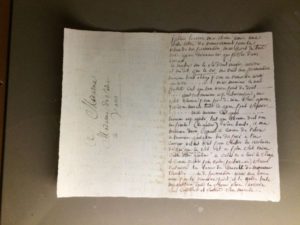 |
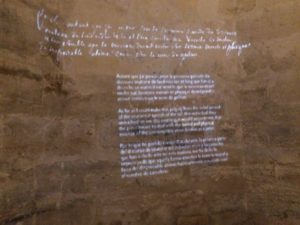 |
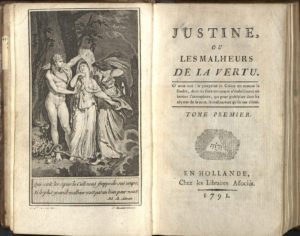 |
| So ended our wonderful day at Vincennes! After a visit to the gift shop, we made our way in the cool, damp weather across the road to a bistro for a nice hot bowl of French onion soup! |
 |

